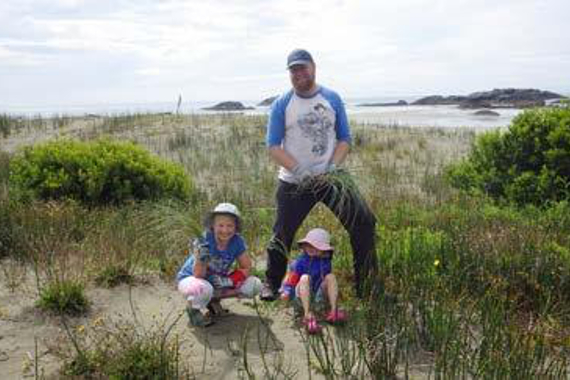
Keeping dunes dynamic
Restoring coastal dunes in Pacific Rim National Park ReserveFootnote *
What’s the issue?

Coastal sand dunes are among Canada’s rarest and most sensitive ecosystems. They exist at the dynamic interface between beaches and forests. Strong ocean winds blow sand off beaches into forests, covering plants, which then grow out over the sand. The dunes and forests are like waves, constantly crashing into one another, creating disturbance-driven habitats favored by rare species like pink sand-verbena, silky beach pea, Edwards’ beach and sand-verbena moths. However, those dynamics are being interrupted by an invasion of non-native grasses, which stabilize the dunes, shifting the coastal zone to forest and further threatening species at risk.
What’s our approach?
- Engage with Indigenous peoples and other stakeholders on restoration plans.
- Remove invasive plants to increase dynamic dune habitat by 2 hectares.
- Increase habitat available for species at risk; develop protocols for translocation of 100 silky beach pea seeds; propagate and plant 200 pink sand-verbena seedlings at the Cheewhat Dunes.
- Increase our understanding of rare species needs and the effectiveness of restoration efforts through monitoring and research partnerships.
- Enable visitors, schools, youth programs, Indigenous peoples and local communities to learn about and contribute directly to dune restoration.
What’s been accomplished?
- Engaged Indigenous partners in planning, restoration and monitoring activities.
- Removed invasive vegetation and restored 2 hectares of Schooner Cove dunes in partnership with Central Westcoast Forest Society and Tla-o-qui-aht First Nation.
- Increased pink sand-verbena by 150 percent and silky beach pea by more than 750 percent by creating new habitat at Schooner Cove (2016 and 2017).
- Surveyed suitable habitat for endangered moths and rare plants; improved our understanding of the status and distribution of species at risk.
- Delivered nine volunteer and interpretive events, including invasive plant pulls where visitors assisted directly in restoration; produced a video highlighting results.
Related links
- Igniting restoration
- Two pines in decline
- Conserving an alpine enigma
- Rescue the fescue
- Historic homecoming
- Wildlife crossings
- Going with the flow
- Propagating success
- Listening to the sea, looking to the future
- Ecosystem on the edge
- Wild about wolves
- Restoring kelp in Gwaii Haanas National Marine Conservation...
- Llgaay gwii sdiihlda, or restoring balance
- Date modified :